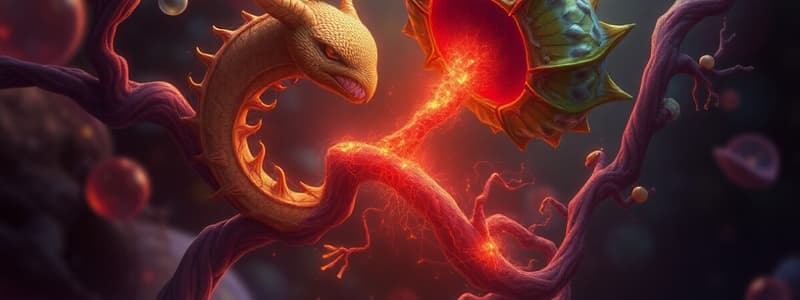Podcast
Questions and Answers
What is a characteristic of asexual reproduction?
What is a characteristic of asexual reproduction?
- Offspring are clones of the parent. (correct)
- It involves gamete formation.
- Offspring are genetically diverse.
- It requires two parents.
Which method is NOT a type of asexual reproduction?
Which method is NOT a type of asexual reproduction?
- Fertilization (correct)
- Binary fission
- Fragmentation
- Budding
What is one disadvantage of sexual reproduction?
What is one disadvantage of sexual reproduction?
- Genetic identicality of offspring.
- Rapid population growth.
- Increased genetic diversity.
- Requires finding a mate. (correct)
What distinguishes K-strategists from R-strategists?
What distinguishes K-strategists from R-strategists?
Which of the following hormones regulates reproductive processes in animals?
Which of the following hormones regulates reproductive processes in animals?
Which statement about gametogenesis is accurate?
Which statement about gametogenesis is accurate?
What is a method of internal fertilization?
What is a method of internal fertilization?
What is a significant advantage of asexual reproduction?
What is a significant advantage of asexual reproduction?
Which branch of biology focuses on the study of heredity and variation?
Which branch of biology focuses on the study of heredity and variation?
What type of cell contains a nucleus?
What type of cell contains a nucleus?
Which of the following is NOT a function of the cell membrane?
Which of the following is NOT a function of the cell membrane?
What process explains how species evolve over time through advantageous traits?
What process explains how species evolve over time through advantageous traits?
Which of the following macromolecules is primarily responsible for encoding genetic information?
Which of the following macromolecules is primarily responsible for encoding genetic information?
Which term describes the interactions between organisms and their environment?
Which term describes the interactions between organisms and their environment?
Which of the following is an example of a prokaryotic organism?
Which of the following is an example of a prokaryotic organism?
What is the jelly-like substance inside a cell where organelles are found?
What is the jelly-like substance inside a cell where organelles are found?
Flashcards are hidden until you start studying
Study Notes
Overview of Reproduction
- Definition: The biological process by which new individual organisms are produced.
- Types:
- Asexual reproduction
- Sexual reproduction
Asexual Reproduction
- Characteristics:
- Involves a single parent.
- Offspring are genetically identical to the parent (clones).
- Methods:
- Binary fission (e.g., bacteria)
- Budding (e.g., yeast)
- Fragmentation (e.g., starfish)
- Vegetative propagation (e.g., plants)
- Advantages:
- Rapid population increase.
- No need for a mate.
- Disadvantages:
- Lack of genetic diversity, making populations vulnerable to diseases.
Sexual Reproduction
- Characteristics:
- Involves two parents.
- Offspring inherit genetic material from both parents, introducing variability.
- Process:
- Gametogenesis: Formation of gametes (sperm and eggs).
- Fertilization: Fusion of gametes to form a zygote.
- Development: Zygote undergoes cell division and differentiation.
- Types:
- External fertilization (e.g., fish, amphibians)
- Internal fertilization (e.g., mammals, reptiles)
- Advantages:
- Increased genetic diversity.
- Better adaptation to changing environments.
- Disadvantages:
- Slower population growth.
- Requires finding a mate.
Key Concepts in Sexual Reproduction
-
Gametogenesis:
- Spermatogenesis: Production of sperm in males.
- Oogenesis: Production of eggs in females.
-
Fertilization:
- Can be:
- External: Occurs outside the body (common in aquatic animals).
- Internal: Occurs inside the female body (common in mammals).
- Can be:
-
Developmental Stages:
- Cleavage: Rapid cell division following fertilization.
- Gastrulation: Formation of germ layers.
- Organogenesis: Development of organs from germ layers.
Reproductive Strategies
-
K-strategists:
- Produce fewer offspring with higher parental investment (e.g., elephants, humans).
-
R-strategists:
- Produce many offspring with lower parental investment (e.g., mosquitoes, bacteria).
Hormonal Regulation
-
In Animals:
- Hormones like estrogen and testosterone regulate reproductive cycles and processes.
-
In Plants:
- Hormones like auxins, gibberellins, and cytokinins influence flowering and fruit development.
Methods of Study
- Fertility Treatments: Techniques such as IVF, artificial insemination to assist in reproductive processes.
- Contraception: Strategies to prevent pregnancy, including hormonal methods, barriers, and surgical options.
Evolutionary Perspective
- Reproductive strategies and mechanisms have evolved to enhance survival and adaptability of species. Genetic variation contributes to the evolution of populations through natural selection.
Reproduction Overview
- Reproduction is the process by which new organisms are created.
- There are two major types: asexual and sexual reproduction.
Asexual Reproduction
- Single parent produces offspring.
- Offspring are genetically identical to the parent.
- Examples of methods:
- Binary fission (bacteria)
- Budding (yeast)
- Fragmentation (starfish)
- Vegetative propagation (plants)
- Advantages include:
- Rapid population increase.
- No need for a mate.
- Disadvantages include:
- Lack of genetic diversity, leaving populations vulnerable to diseases.
Sexual Reproduction
- Two parents contribute genetic material to offspring, creating variability.
- Process involves:
- Gametogenesis: Formation of gametes (sperm and eggs)
- Fertilization: Fusion of gametes to form a zygote
- Development: Zygote develops through cell division and differentiation.
- Types:
- External fertilization (fish, amphibians)
- Internal fertilization (mammals, reptiles)
- Advantages include:
- Increased genetic diversity.
- Better adaptation to changing environments.
- Disadvantages include:
- Slower population growth.
- Requires finding a mate.
Gametogenesis
- Spermatogenesis: Sperm production in males.
- Oogenesis: Egg production in females.
- Fertilization: Fusion of sperm and egg.
- External fertilization occurs outside the body (aquatic animals).
- Internal fertilization occurs inside the female body (mammals).
Developmental Stages
- Cleavage: Rapid cell division after fertilization.
- Gastrulation: Formation of germ layers (ectoderm, mesoderm, endoderm).
- Organogenesis: Development of organs from germ layers
Reproductive Strategies
- K-strategists: Produce fewer offspring with a high investment in parental care (elephants, humans)
- R-strategists: Produce many offspring with low parental investment (mosquitoes, bacteria)
Hormonal Regulation
- Animals: Hormones like estrogen and testosterone regulate reproductive cycles and processes.
- Plants: Hormones like auxins, gibberellins, and cytokinins influence flowering and fruit development.
Methods of Study
- Fertility Treatments: Techniques like IVF (in vitro fertilization) and artificial insemination assist in reproduction.
- Contraception: Strategies to prevent pregnancy including hormonal methods, barriers, and surgical options.
Evolutionary Perspective
- Reproductive strategies and mechanisms evolved to enhance survival and adaptability of species.
- Genetic variation through reproduction contributes to the evolution of populations via natural selection.
Biology: The Study of Life
- Definition: The scientific exploration of living organisms, focusing on structure, function, growth, evolution, and distribution.
- Branches:
- Botany: Study of plants
- Zoology: Study of animals
- Microbiology: Study of microorganisms
- Genetics: Study of heredity and variation
- Ecology: Study of interactions between organisms and their environment
- Cell Biology: Study of cellular structure and function
- Physiology: Study of functions and mechanisms in living systems
- Branches:
The Fundamental Unit: The Cell
- Basic Unit: The building block of all living organisms.
- Types:
- Prokaryotic: Lack a nucleus (e.g., bacteria)
- Eukaryotic: Possess a nucleus (e.g., plants and animals)
- Types:
- Key Structures:
- Cell membrane: Regulates the passage of substances into and out of the cell.
- Cytoplasm: A jelly-like fluid where cell components are located.
- Organelles: Specialized structures within the cell, each with a specific function (e.g., mitochondria for energy production, ribosomes for protein synthesis).
Inheritance and Variation: Genetics
- DNA Structure: A double helix composed of nucleotides (adenine, thymine, cytosine, guanine).
- Genes: Segments of DNA that carry the instructions for building proteins and determining traits.
- Inheritance: How traits are passed from parents to offspring.
- Mendelian inheritance: Traits passed on according to specific ratios.
- Non-Mendelian inheritance: Involves more complex patterns like incomplete dominance, co-dominance, and polygenic inheritance.
Evolution: The Story of Life's Changes
- Theory of Evolution: Proposed by Charles Darwin, explaining how species change over time through natural selection.
- Natural Selection: The driving force behind evolution.
- Variability: Individuals within a population exhibit differences in traits.
- Inheritance: Traits are passed on to offspring.
- Differential survival and reproduction: Individuals with advantageous traits are more likely to survive and reproduce, passing those traits to the next generation.
Interconnectedness: Ecology
- Ecosystems: Communities of living organisms interacting with their physical environment.
- Biomes: Large geographical areas with distinctive plant and animal life (e.g., forests, deserts, tundras).
- Food Chains and Webs: Illustrate the flow of energy through trophic levels, including producers, consumers, and decomposers.
Human Biology: Understanding Ourselves
- Body Systems: Interacting networks that maintain life.
- Circulatory: Transports blood, nutrients, and gases throughout the body.
- Respiratory: Enables the exchange of oxygen and carbon dioxide.
- Digestive: Breaks down food into usable nutrients.
- Nervous: Controls body functions through nerve impulses.
- Immune: Defends against diseases and foreign invaders.
Biochemistry: The Chemistry of Life
- Macromolecules: Large, complex molecules essential for life.
- Carbohydrates: Provide energy.
- Proteins: Serve various functions, including building tissues and acting as enzymes.
- Lipids: Store energy and provide insulation.
- Nucleic acids: Carry genetic information (DNA, RNA).
- Metabolism: All biochemical reactions occurring within an organism.
- Catabolic pathways: Break down complex molecules into simpler ones, releasing energy.
- Anabolic pathways: Build up complex molecules from simpler ones, requiring energy.
The Importance of Biology
- Understanding Life: Crucial for comprehending life processes and their applications in various fields.
- Applied Biology: Plays a key role in medicine, environmental policy, agriculture, and biotechnology.
- Addressing Global Issues: Contributes to solving global challenges such as climate change, food security, and health crises.
Studying That Suits You
Use AI to generate personalized quizzes and flashcards to suit your learning preferences.




